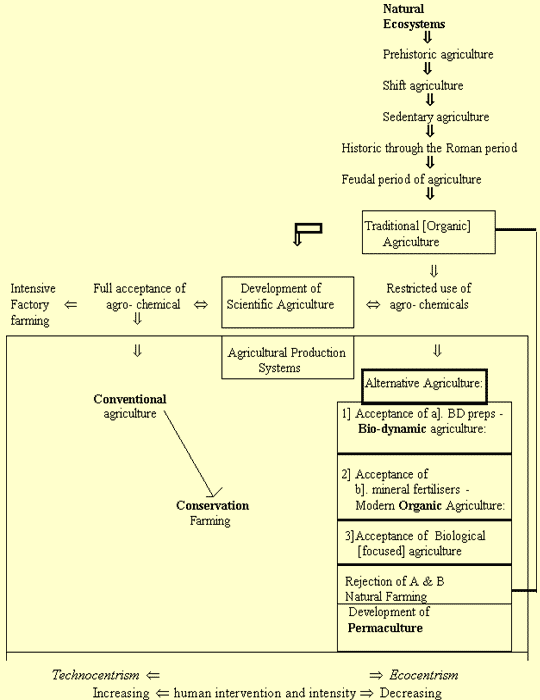CONCLUSION[S]
This document has covered the evolution of agriculture and the identification of current agricultural production systems
with their backgrounds, philosophies and practices. It represents a snapshot of the dynamic and changing
nature of current agricultural production systems. Historical evidence demonstrates, with a few exceptions,
that most large agricultural systems supporting urban civilisations have been non-sustainable [Carter, Dale, 1974].
Modern civilisation has benefited from the industrial revolution with the invention of labour-saving machinery
and technology which has allowed the intensification of production and the increased use of agro-chemicals.
The soil has played a changing role in Western industrialised agriculture as initially it had to appease the
hunger of the stomach of local prehistoric agriculturalists [Howard, 1947]. Then a subsidiary hunger developed
as civilisations grew and the bounty from the soil assisted in building wealth which accumulated in urban
cities [Carter, Dale, 1974]. Modern Western industrialised agriculture has a hunger for profit, which must
be appeased, so agri-culture is being displaced by 'agri-business'.
The combined effects of increasing chemical usage and growing plants for a profit has contributed to the
formation of an identifiable conservative sub-group. This group has various forms of alternative production
systems, although they share common goals and beliefs in avoiding the use of chemicals and supporting natural
methods of farming by using the soil to grow healthy plants and selling life sustaining food rather than just
a perishable commodity [Bock, 1995]. The evolution of agriculture through different identifiable timeframes
in Australia has culminated in the establishment of five definable agricultural production systems with their
own philosophies and specific management practices. The first well organised grower based 'alternative' movement
was Bio-dynamics which was established in the 1920's in response to the degeneration of once sustainable
agricultural systems [eds Edwards et al. 1990]. There is a spiritual aspect to Bio-dynamics, which isolates
it from the other alternative methods. [eds Edwards et al. 1990]. As the 'alternative' movement was recognised,
this led to the opposing movement being identified as the 'conventional' agricultural movement [Reeve, 1990].
Between these two extreme schools the conservation farming approach developed though often using agrochemicals
intensively it recognises and considers broader ecological factors. The following highly simplified illustration
is an outline to the historical and evolutional development of agricultural systems.

Figure 1.2 An outline of the historical and evolutional development of agricultural systems with the top
of the page showing the oldest systems and the bottom the youngest. In addition the two extremes of
technocentric and ecocentric based agriculture is shown.
Conventional agriculture fully accepts the use of modern science to satisfy its goal of profit maximisation.
Conservation farming adopts a more ecologically responsible philosophy and uses chemicals and other alternative
means to achieve desired results. Bio-dynamics combines natural 'organic' farming methods with the use of Bio-dynamic
preparations as optional management tools. It has a philosophy of self sufficiency and emphasises the importance of a
dynamic living soil and humus production. Biological farming focus on the create of healthy living organisms and not the
destruction of them. Organic agriculture chooses to limit itself to natural methods only, while Permaculture adopts
most alternative practices and focuses on design and the inclusion of trees. Permaculture is the only philosophy
which encompasses a global perspective.
Over the past few decades the alternative agricultural movement has grown slowly in popularity and legitimacy
[eds Edwards et al. 1990; Reeve, 1990]. The alternative approaches of Organic, Biological, Bio-dynamic and
Permaculture are currently enjoying a resurgence of interest as they are distinct from the conventional approach.
The information contained in this publication has been formulated in good faith, the contents do
not take into account all the factors which need to be considered before putting that information
into practice. Accordingly, no person should rely on anything contained herein as a substitute for
specific professional advice.
S.O.S. Rev 9.2 All rights reserved.
Contact: www.healthyag.com © Gwyn Jones 2001
Back to Alternative Agriculture Menu
|

![]() Home
Home![]()
![]() History
History![]()
![]() Catalogue
Catalogue![]()
![]() Courses
Courses![]()
![]() Top Ten
Top Ten![]()
![]() Links
Links![]()
![]() Site Map
Site Map![]()
![]() Contact
Contact


